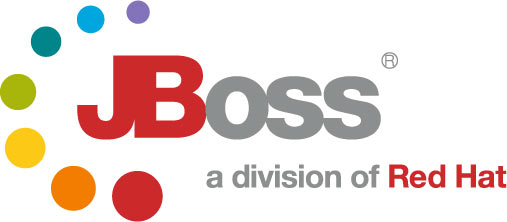
JBESB-GS-

Legal Notices
The information contained in this documentation is subject to change without notice.
JBoss Inc. makes no warranty of any kind with regard to this material, including, but not limited to, the implied warranties of merchantability and fitness for a particular purpose. JBoss Inc. shall not be liable for errors contained herein or for incidental or consequential damages in connection with the furnishing, performance, or use of this material.
Java™ and J2EE is a U.S. trademark of Sun Microsystems, Inc. Microsoft® and Windows NT® are registered trademarks of Microsoft Corporation. Oracle® is a registered U.S. trademark and Oracle9™, Oracle9 Server™ Oracle9 Enterprise Edition™ are trademarks of Oracle Corporation. Unix is used here as a generic term covering all versions of the UNIX® operating system. UNIX is a registered trademark in the United States and other countries, licensed exclusively through X/Open Company Limited.
Copyright
JBoss, Home of Professional Open Source Copyright 2006, JBoss Inc., and individual contributors as indicated by the @authors tag. All rights reserved.
See the copyright.txt in the distribution for a full listing of individual contributors. This copyrighted material is made available to anyone wishing to use, modify, copy, or redistribute it subject to the terms and conditions of the GNU General Public License, v. 2.0. This program is distributed in the hope that it will be useful, but WITHOUT A WARRANTY; without even the implied warranty of MERCHANTABILITY or FITNESS FOR A PARTICULAR PURPOSE.
See the GNU General Public License for more details. You should have received a copy of the GNU General Public License, v. 2.0 along with this distribution; if not, write to the Free Software Foundation, Inc., 51 Franklin Street, Fifth Floor, Boston, MA 02110-1301, USA.
Software Version
JBoss ESB 4.5
Restricted Rights Legend
Use, duplication, or disclosure is subject to restrictions as set forth in contract subdivision (c)(1)(ii) of the Rights in Technical Data and Computer Software clause 52.227-FAR14.
©
Copyright
Configuration
In
order to communicate with the SOA Software registry, you will have to
configure JBoss ESB to communicate with the SOA Software registry. In
order to do this, the first thing you need to do is to point the
JBoss ESB towards the SOA Software registry.
This text assumes you have a running JBoss Application/ESB Server, version 4.5.GA.
Edit server/<profile>/deploy/jbossesb.sar/jbossesb-properties.xml and change the following lines :
<property name="org.jboss.soa.esb.registry.queryManagerURI" value="org.apache.juddi.registry.local.InquiryService#inquire"/>
<property name="org.jboss.soa.esb.registry.lifeCycleManagerURI" value="org.apache.juddi.registry.local.PublishService#publish"/>
To the following (and make sure to edit the queryManagerURI and the lifeCycleManagerURI to match the URLs from your installation of SOA Workbench) : <property name="org.jboss.soa.esb.registry.uddi.maxRows" value="100"/>
<property name="org.jboss.soa.esb.registry.queryManagerURI" value="http://stacks2:9901/uddi/inquiry_v2"/>
<property name="org.jboss.soa.esb.registry.lifeCycleManagerURI" value="http://stacks2:9901/uddi/publish_v2"/>
Change jbossesb-properties.xml:
<property name="org.jboss.soa.esb.scout.proxy.transportClass" value="org.apache.ws.scout.transport.LocalTransport"/> To
<property name="org.jboss.soa.esb.scout.proxy.transportClass" value="org.apache.ws.scout.transport.AxisTransport"/> Also, within jbossesb-properties.xml, change :
<property name="org.jboss.soa.esb.registry.user" value="administrator"/>
<property name="org.jboss.soa.esb.registry.password" value="password"/>
to match the SOA Workbench user and password you'll be using.
Copy
a recent version of Apache Axis and Apache Commons Discovery into
server/<profile>/lib. The integration was tested using
axis-1.4.jar and commons-discovery-0.2.jar. Download
axis-bin-1_4.tar.gz from the Apache Axis site
(http://ws.apache.org/axis/)
to find these JARs.
Configure the guest user in Workbench to the guest role. Go to the top level registry node in Workbench on the right hand side of the screen and click on the second-level “Security” tab (within the Workbench hierarchy). Hit modify on “Guest” under “Role Memberships :
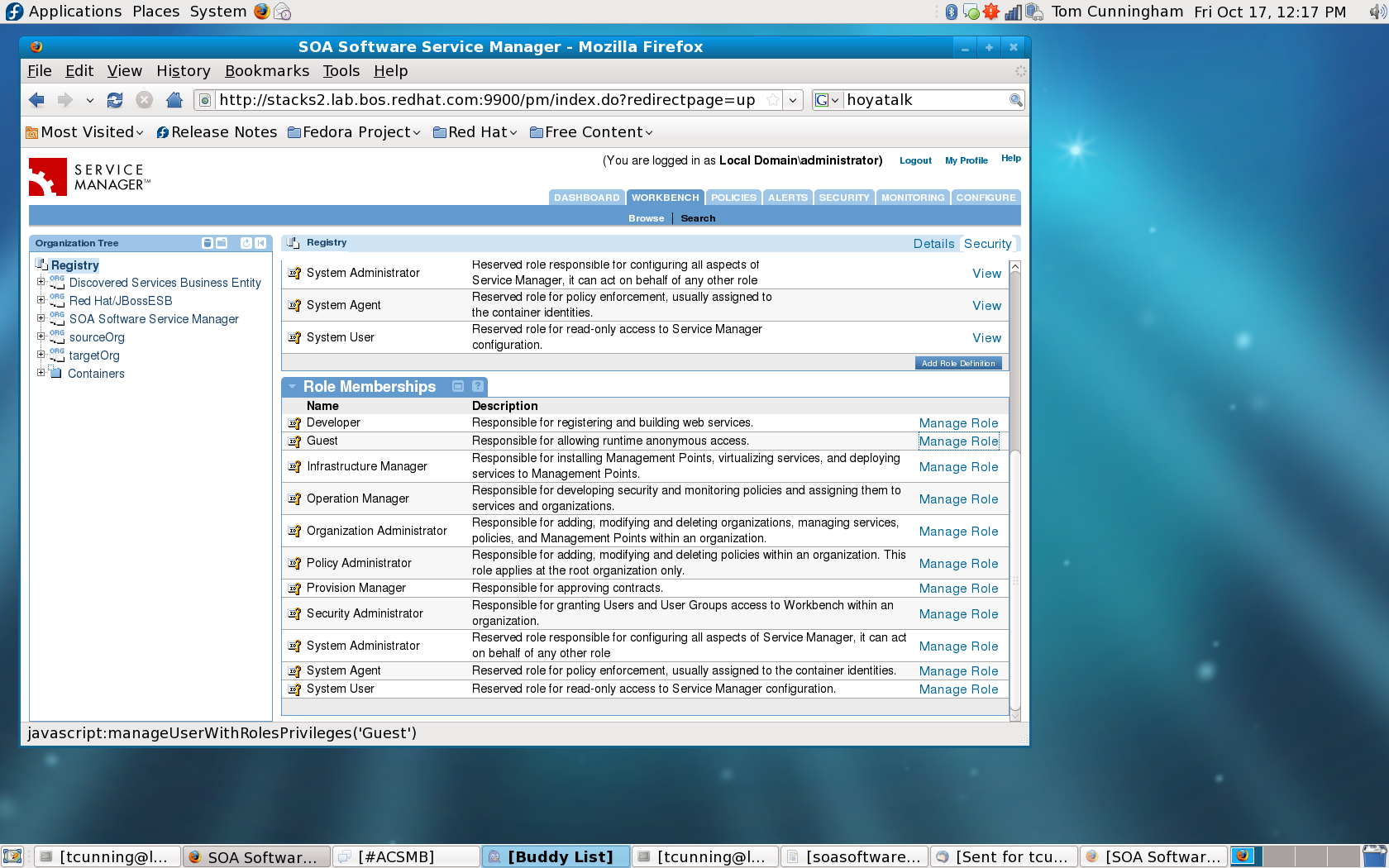
Search for the user “guest”, and add them to the Guest Role by selecting the checkbox next to “guest” clicking “Apply” :
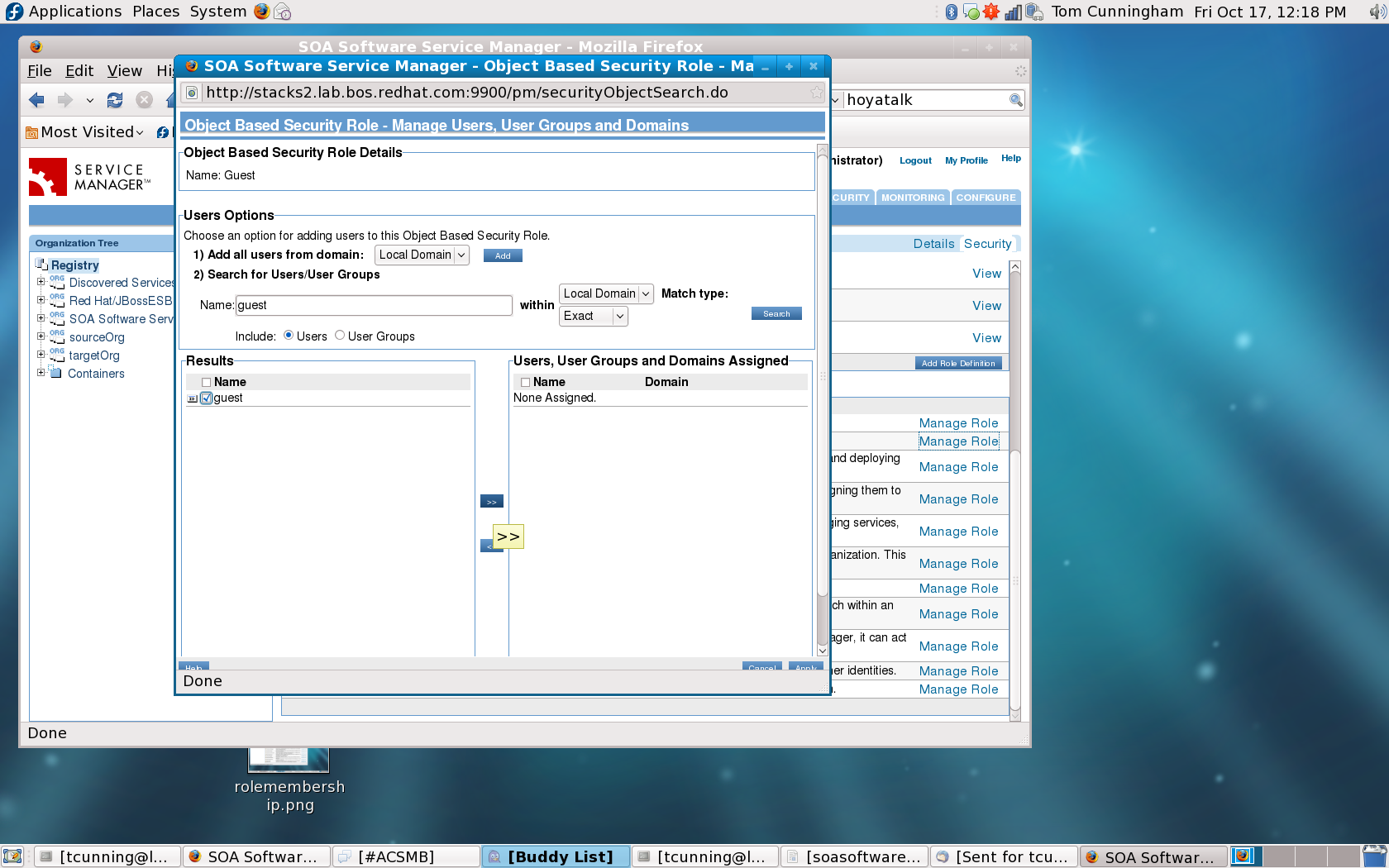
Change the Workflow so that ESB services are published upon creation. Click on the “Configure” tab and then select “Workflow”. View the Workflow Definition, save it to your local disk, and then change the function type line under @create to <function type="publish" /> and the step attribute to “100”. After saving, Update the Workflow to the local copy you have saved.
Before:
<action id="1" name="@create">
<results>
<unconditional-result old-status="Created" status="Draft" step="100" owner="${caller}"/>
</results>
<post-functions>
<function type="setLifecycleStage">
<arg name="stage">Design</arg>
</function>
</post-functions>
</action>
After:
<action id="1" name="@create">
<results>
<unconditional-result old-status="Pending Approval" status="Pending Approval" step="300" owner="${caller}"/>
</results>
<post-functions>
<function type="setLifecycleStage">
<arg name="stage">Published</arg>
</function>
</post-functions>
</action>
Start JBossESB :
cd
bin
run.bat (if on Windows) or run.sh (on Unix)
Read
product/docs/GettingStarted.pdf and follow the directions for running
the Helloworld QS.
You
can manage your services through Workbench – as you notice in the
left frame of the screenshot below, services register with the SOA
Software Workbench.
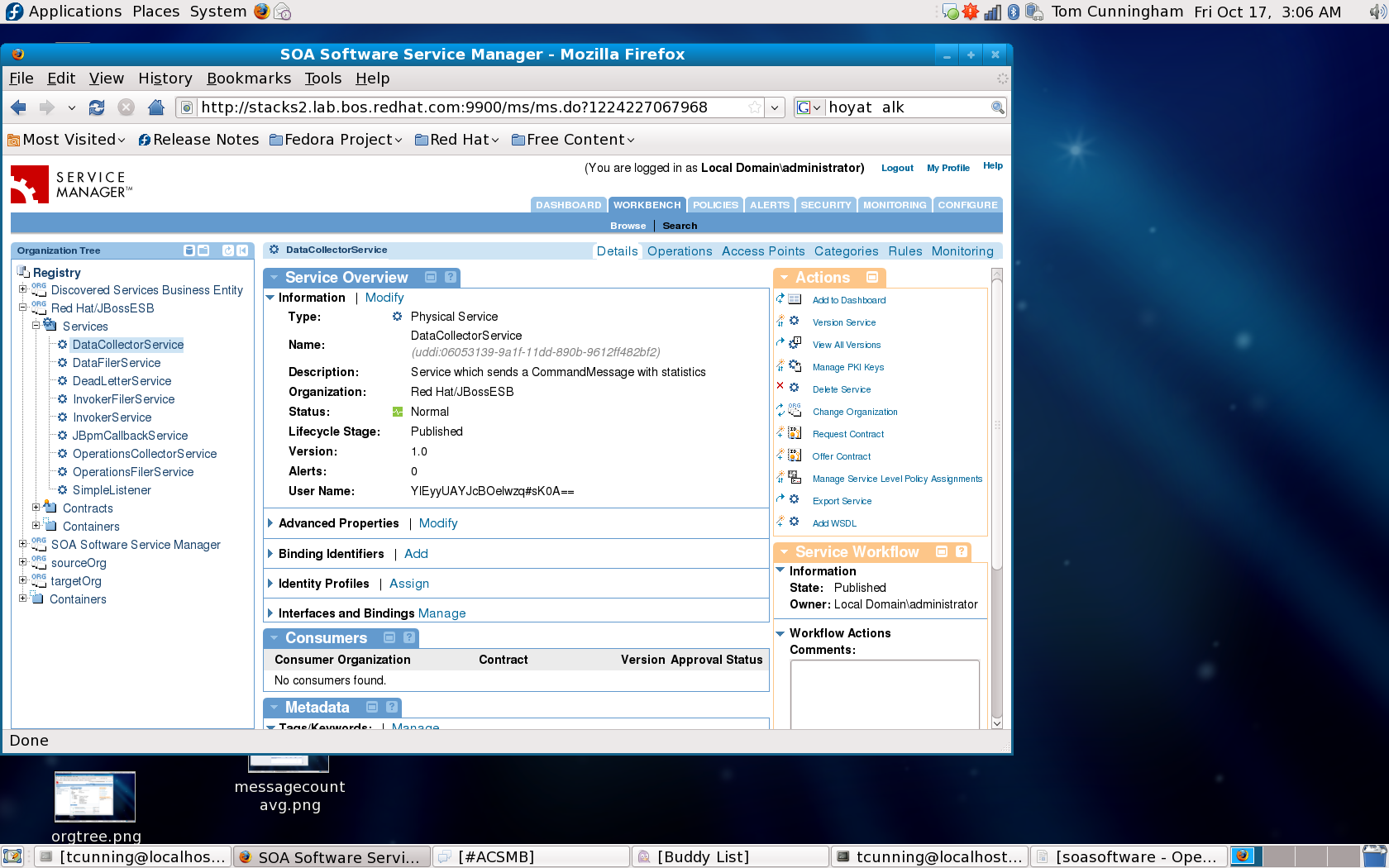
Search:
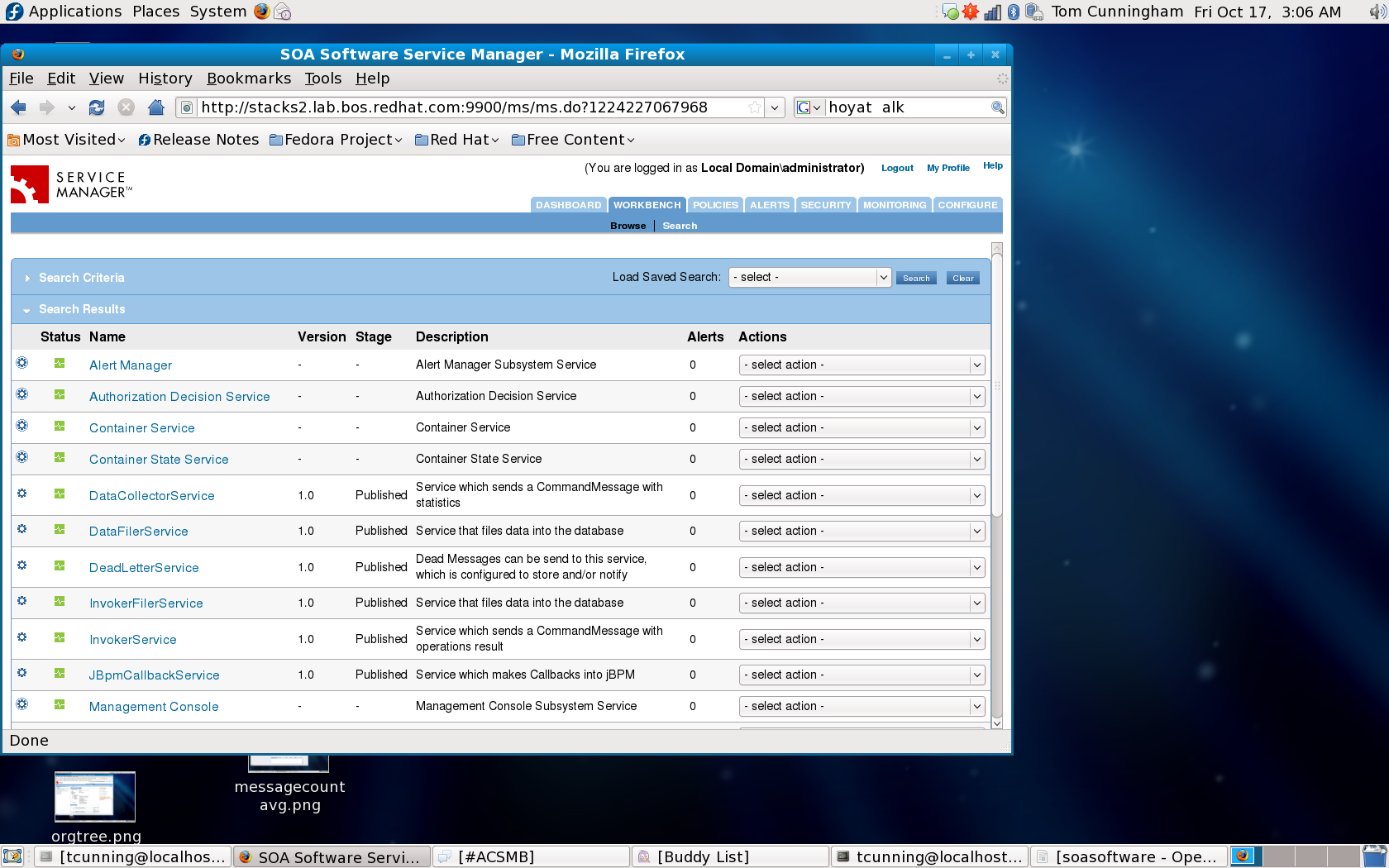
The
“Search” option within Workbench allows the user to manage their
services and shows the state, version, description, and number of
alerts produced from those services.